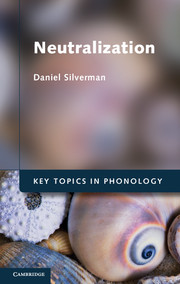Book contents
- Frontmatter
- Contents
- List of Figures
- Preface
- Acknowledgments
- 1 The rhyme and the reason of neutralization
- Part I Rhyme
- Section A Observation and description
- 2 Topology
- 3 Taxonomy
- 4 Typology
- Section B False positives
- Section C Explanation
- Section D Exemplification
- Part II Reason
- Glossary
- References
- Language index
- Subject index
3 - Taxonomy
Published online by Cambridge University Press: 05 November 2012
- Frontmatter
- Contents
- List of Figures
- Preface
- Acknowledgments
- 1 The rhyme and the reason of neutralization
- Part I Rhyme
- Section A Observation and description
- 2 Topology
- 3 Taxonomy
- 4 Typology
- Section B False positives
- Section C Explanation
- Section D Exemplification
- Part II Reason
- Glossary
- References
- Language index
- Subject index
Summary
Having now briefly considered patterns of neutralization from a topological perspective, in this chapter we move on to consider the taxonomy of neutralization, where taxonomy refers to the inventorying of both common and uncommon patterns of neutralization, and also any implicational hierarchies that might be established (though these await detailed discussion in Chapter 8). Our point of reference herein is the work of Jun (1995, 2004, 2010), who taxonomizes patterns of neutralization into positions that typically resist and/or trigger neutralization, and positions that typically undergo neutralization. Resisting and/or triggering elements include (1) prevocalic consonants, (2) stressed elements, (3) initial elements, and (4) roots. Undergoers include the flips of these positions: (1) non-prevocalic consonants, (2) unstressed elements, (3) non-initial elements, and (4) affixes. In this chapter we consider these contexts, concluding with Jun that values in resistor/trigger positions tend to possess more robust acoustic cues, while values in positions that undergo neutralization tend to possess weaker cues. Regarding consonants in particular, positions of cue robustness/stability display a strong tendency to be lexically prevocalic, whereas positions of neutralization/assimilation tend to be lexically non-prevocalic.
JUN (2010): LEXICAL PREVOCALIC VERSUS LEXICAL NON-PREVOCALIC CONSONANTS
Jun (2010) focuses primarily on the asymmetry between lexically prevocalic consonants (as stated, typical resistors and triggers of neutralization) and lexically non-prevocalic consonants (recall, typical undergoers of neutralization). He considers, in turn, patterns of neutralization involving (1) oral and (2) laryngeal features, further observing a distinction between (1) assimilatory and (2) non-assimilatory patterns of neutralization. Keep in mind our working definition of neutralization: neutralization is a conditioned limitation on the distribution of a language's contrastive values. Consequently, such patterns are neutralizing only if the relevant values are contrastive in some other context. Thus, for example, consider a language that possesses both voiced and voiceless stops in prevocalic contexts (say, p t k b d ɡ). Here, the presence of only a voice-assimilated version of these values in certain contexts may be characterized as a case of neutralization (specifically, an assimilatory laryngeal neutralization). However, if a language has only one series of stops, then these stops' voicing assimilation is not an instance of neutralization. With this caveat in mind, we might expect (at least):
Assimilatory oral neutralization
Assimilatory laryngeal neutralization
Non-assimilatory oral neutralization
Non-assimilatory laryngeal neutralization
Assimilatory oral and assimilatory laryngeal neutralization
Assimilatory oral and non-assimilatory laryngeal neutralization
Non-assimilatory oral and assimilatory laryngeal neutralization
Non-assimilatory oral and non-assimilatory laryngeal neutralization.
- Type
- Chapter
- Information
- Neutralization , pp. 31 - 41Publisher: Cambridge University PressPrint publication year: 2012



